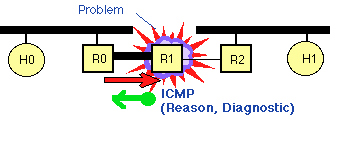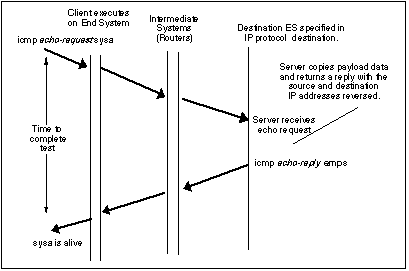
The Internet Control Message Protocol (ICMP) [RFC792] protocol is classic example of a client server application. The ICMP server executes on all IP end system computers and all IPv4 intermediate systems (i.e routers). The protocol is used to report problems with delivery of IP datagrams within an IP network. It can be sued to show when a particular End System (ES) is not responding, when an IP network is not reachable, when a node is overloaded, when an error occurs in the IP header information, etc. The protocol is also frequently used by Internet managers to verify correct operations of End Systems (ES) and to check that routers are correctly routing packets to the specified destination address.

ICMP messages generated by router R1, in response to message sent by H0 to H1 and forwarded by R0. This message could, for instance be generated if the MTU of the link between R0 and R1 was smaller than size of the IP packet, and the packet had the Don't Fragment (DF) bit set in the IP packet header. The ICMP message is returned to H0, since this is the source address specified in the IP packet that suffered the problem.

An ICMP message consisting of 4 bytes of PCI and an optional message payload.
The format of an ICMP message is shown above. The 8-bit type code identifies the types of message. This is followed by at least the first 28 bytes of the packet that resulted in generation of the error message (i.e. the network-layer header and first 8 bytes of transport header). This payload is, for instance used by a sender that receives the ICMP message to perform Path MTU Discovery so that it may determine IP destination address of the packet that resulted in the error. Longer payloads are also encouraged (which can help better identify the reason why the ICMP message was generated and which program generated the original packet).
The figure below shows the encapsulation of ICMP over an Ethernet LAN using an IP network layer header, and a MAC link layer header and trailer containing the 32-bit checksum:

Encapsulation for a complete ICMP packet (not showing the Ethernet preamble)
It is the responsibility of the network layer (IP) protocol to ensure that the ICMP message is sent to the correct destination. This is achieved by setting the destination address of the IP packet carrying the ICMP message. The source address is set to the address of the computer that generated the IP packet (carried in the IP source address field) and the IP protocol type is set to "ICMP" to indicate that the packet is to be handled by the remote end system's ICMP client interface.
RFC792 specifies the Internet Control Message Protocol (ICMP) that is used with the Internet Protocol version 4 (IPv4). It defines, among other things, a number of error messages that can be used by an end-system and intermediate systems to report errors back to the sending system. The host requirements [RFC1122] classifies ICMP these error messages into those that indicate "soft errors" (advising of problems), and those that indicate "hard errors" (which need to be responded to).
A version of ICMP has also been defined for IPv6, called ICMPv6 [RFC4443]. This subsumes all the equivalent functions of ICMP for IPv4 and adds other network-layer functions. ICMP error messages are up to 1280 bytes in size, and therefore always carry a substantial number of bytes from the packet that generated the error being reported.
The "ping" program contains a client interface to ICMP. It may be used by a user to verify an end-to-end Internet Path is operational. The ping program also collects performance statistics (i.e. the measured round trip time and the number of times the remote server fails to reply. Each time an ICMP echo reply message is received, the ping program displays a single line of text. The text printed by ping shows the received sequence number, and the measured round trip time (in milliseconds). Each ICMP Echo message contains a sequence number (starting at 0) that is incremented after each transmission, and a timestamp value indicating the transmission time.

Use of the ping program to test whether a particular computer ("sysa") is operational.
The operation of ICMP is illustrated in the frame transition diagram shown above. In this case there is only one Intermediate System (IS) (i.e. IP router). In this case two types of message are involved the ECHO request (sent by the client) and the ECHO reply (the response by the server). Each message may contain some optional data. When data are sent by a server, the server returns the data in the reply which is generated. ICMP packets are encapsulated in IP for transmission across an internet.
Example:
An IPv4 End System uses the ping program to send an echo-request message with a payload of 1000 Bytes. What is the total size of the Ethernet frame (excluding the preamble)?
Determine packet headers: Ethernet Frame Header (14B); IP Header (20B); ICMP Mesage (1008 B); Ethernet Trailer (4B). Answer = 14+20+8+1000+4 = 1046 Bytes
This calculation ignores the Inter-Frame Gap (IFG) introduced between Ethernet Frames, and is requested to ignore the preamble.
Note:
The "traceroute" program also contains a client interface to ICMP. Like the "ping" program, it may be used by a user to verify an end-to-end Internet Path is operational, but also provides information on each of the Intermediate Systems
J. Postel.Internet Control Message Protocol, RFC 792 (STD0005)
Braden, R., Ed., "Requirements for Internet Hosts - Communication Layers", STD 3, RFC 1122, October 1989.
Conta, A., Deering, S., and M. Gupta, Ed., "Internet Control Message Protocol (ICMPv6) for the Internet Protocol Version 6 (IPv6) Specification", RFC 4443, March 2006.
Davies, E. and J. Mohacsi, "Recommendations for Filtering ICMPv6 Messages in Firewalls", RFC 4890, May 2007.